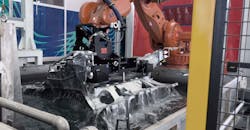Ford Motor Co. is taking a new approach to battery-electric vehicle design and production, and announced a $2-billion capital investment at the Louisville, KY, Assembly plant to launch a series of more affordable EVs by 2027. The investment will establish its new Ford Universal EV Platform, which the automaker described as “a simple, efficient, flexible ecosystem to deliver a family of affordable, electric, software-defined vehicles,” according to its announcement.
“We took a radical approach to a very hard challenge: Create affordable vehicles that delight customers in every way that matters – design, innovation, flexibility, space, driving pleasure, and cost of ownership – and do it with American workers,” stated president and CEO Jim Farley.
He added that the Universal EV Platform “represents the most radical change on how we design and how we build vehicles at Ford since the Model T.”
An important detail of Ford’s investment will be its application of aluminum “unicasting” technology for vehicle structures. This detail confirms various reports over the past year that Ford would adopt a version of megacasting – the high-pressure diecasting approach to producing vehicle chassis – more than a decade after it switched to outsourcing castings for its U.S. operations.
Megacasting was pioneered by Tesla and more recently embraced by Honda Motors, among other automakers.
Ford has been recruiting individuals for roles related to the new HPDC process, like Unicasting Tooling Engineer and Casting Process Engineer.
The first product of the new Ford Universal EV Platform will be a midsized four-door electric pickup truck that the automaker stated will cost around $30,000. Subsequent EV models were not announced, but Ford’s graphics suggest the platform could be extended to sedans, SUVs, and service vans.
The transition to the new EV platform will mean Ford discontinues production of the Ford Escape and Lincoln Corsair at Louisville.
Farley noted the new vehicle platform has 20% fewer component parts than a typical vehicle, with 25% fewer fasteners, and the assembly process will feature 40% fewer workstations and 15% faster assembly.
A novel development will be a new “assembly tree” in place of an assembly line, as three subassembly “kits” proceed in parallel before being combined together.
Using aluminum unicastings in place of dozens of individual cast parts for the front and rear vehicle structures will simplify and accelerate assembly. The front and rear sections are combined with a third that comprises the passenger compartment with the battery deck below it. The three sections are joined to complete the vehicle.
The automaker noted the Ford Universal EV Production System will improve workplace ergonomics for employees by reducing twisting, reaching, and bending.
Ford stated that the new Universal EV Platform will create or secure 4,000 jobs at Louisville and at the BlueOval Battery Park in Michigan, where the new vehicles’ lithium-iron-phosphate batteries will be assembled. Earlier, the automaker committed $3 billion to that project.
Louisville Assembly Plant will expand by 52,000 square feet to accommodate the new production process.
About the Author
Robert Brooks
Content Director
Robert Brooks has been a business-to-business reporter, writer, editor, and columnist for more than 20 years, specializing in the primary metal and basic manufacturing industries. His work has covered a wide range of topics, including process technology, resource development, material selection, product design, workforce development, and industrial market strategies, among others.
